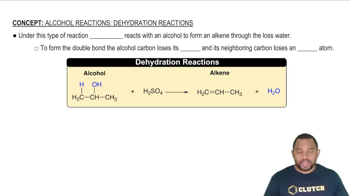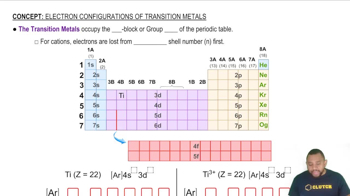The accompanying graph shows plots of ln k versus 1/𝑇 for two different reactions. The plots have been extrapolated to the y-intercepts. Which reaction (red or blue) has b. the larger value for the frequency factor, A? [Section 14.4]
Ch.14 - Chemical Kinetics
Chapter 14, Problem 13
Based on the following reaction profile, how many intermediates are formed in the reaction A⟶C? How many transition states are there? Which step, A⟶B or B⟶C, is the faster? For the reaction A⟶C, is Δ𝐸 positive, negative, or zero? [Section 14.5]
 Verified step by step guidance
Verified step by step guidance1
insert step 1> Identify the number of peaks and valleys in the reaction profile. Each peak represents a transition state, and each valley represents an intermediate.
insert step 2> Count the number of valleys to determine the number of intermediates formed in the reaction A⟶C.
insert step 3> Count the number of peaks to determine the number of transition states in the reaction A⟶C.
insert step 4> Compare the activation energies of the steps A⟶B and B⟶C. The step with the lower activation energy is the faster step.
insert step 5> Determine the overall change in energy (Δ𝐸) for the reaction A⟶C by comparing the energy of the reactants (A) and the products (C). If the energy of C is lower than A, Δ𝐸 is negative; if higher, Δ𝐸 is positive; if the same, Δ𝐸 is zero.

Verified video answer for a similar problem:
This video solution was recommended by our tutors as helpful for the problem above.
Video duration:
2mWas this helpful?
Key Concepts
Here are the essential concepts you must grasp in order to answer the question correctly.
Reaction Profile
A reaction profile is a graphical representation of the energy changes that occur during a chemical reaction. It typically shows the energy of reactants, products, intermediates, and transition states as the reaction progresses. Understanding the profile helps identify the energy barriers and the overall energy change (ΔE) of the reaction, which is crucial for determining the number of intermediates and transition states.
Recommended video:
Guided course

Alcohol Reactions: Dehydration Reactions
Intermediates and Transition States
Intermediates are species that are formed during the reaction but are not present in the final products; they exist at local energy minima on the reaction profile. Transition states, on the other hand, are high-energy states that occur at the peaks of the energy profile, representing the point of maximum energy along the reaction pathway. The number of each can be determined by analyzing the reaction profile.
Recommended video:
Guided course

Transition Metals
Activation Energy and Reaction Rate
Activation energy is the minimum energy required for a reaction to occur, influencing the rate of the reaction. The step with the lower activation energy is typically the faster step. By comparing the energy barriers of the steps A⟶B and B⟶C on the reaction profile, one can determine which step is faster and infer the sign of ΔE based on the overall energy difference between reactants and products.
Recommended video:
Guided course

Average Rate of Reaction
Related Practice
Textbook Question
Textbook Question
The following graph shows two different reaction pathways for the same overall reaction at the same temperature. Is each of the following statements true or false? (b) For both paths, the rate of the reverse reaction is slower than the rate of the forward reaction.
Textbook Question
Consider the diagram that follows, which represents two steps in an overall reaction. The red spheres are oxygen, the blue ones are nitrogen, and the green ones are fluorine. d. Write the rate law for the overall reaction if the first step is the slow, rate-determining step. [Section 14.5]
Textbook Question
(b) Name three factors that can affect the rate of a chemical reaction.
Textbook Question
(a) What are the units usually used to express the rates of reactions occurring in solution?
